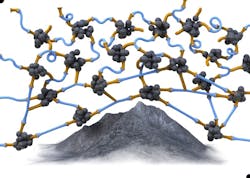Tires Adapt to Changing Applications
Technology is driving equipment productivity, but one sure way to hinder those gains rests in a component that remains basic: rubber tires. A damaged tire brings to a stop not only the machine under which it rests, but also any other equipment involved in the task being performed. A haul truck cannot carry the material just loaded by the shovel if it has blown a tire.
“Especially on automatic driverless vehicles (ADV), the tires cannot be an issue,” says Mike Dembe, executive director, product management for the construction business unit at Camso Tires.
“You can’t go a week without reading about autonomous vehicles in mining and construction,” he says. “Because there is no operator to avoid impacts, we need to build tires that allow for environmental conditions without a person to fix a problem.”
Tires for ADV require the same levels of reliability and durability as those used on operator-driven equipment, but they also require some engineered forgiveness if the ADV finds its way into a tire-bruising situation. With this in mind, tire makers are approaching the ADV market in several ways.
The addition of the autonomous vehicle market doesn’t necessarily mean tire makers need to reinvent the wheel—or tire. Titan is wisely assessing the features and benefits of its current products for use in the ADV market. Johni Francis, global OTR product manager, says Titan is addressing the autonomous vehicle tire market’s requirements by taking an in-depth field review of their current product line. To analyze its tires in actual operating conditions, Titan is partnering with a large OEM and performing rigorous testing in autonomous mining applications to determine what conditions specific to driverless vehicle operations have on Titan’s tire performance.
New Tire Developments
Click to enlarge images and read about the tires.
“When allowed to work in a consistent manner with no variations due to operator skills, our standard tires are showing great promise,” Francis says. “Autonomous vehicle tires working in a consistent pattern are delivering better fuel economy and displaying less wear because the tires don’t run through three shift changes and three different operator styles.” Francis says the use of autonomous vehicles in mining and material handling should be a promising market.
Electric-battery-powered equipment is also forcing tire makers to look at their products. Tires for electric equipment need to balance tread patterns and rolling resistance. The better the tire’s rolling resistance, the longer the vehicle will operate between charges. On the other hand, low-level rolling resistance often impacts traction that is vital to productivity. Dembe says Camso is looking at low-level-resistance rubber compounds.
Smart tire technology
Linking tire telemetry to everyone responsible for that tire’s health and well-being is rapidly becoming the best way to stop tire-related downtime. In 2016, Continental re-entered the construction tire market and is using its return as an opportunity to look at product designs and usage applications to see how telematics can contribute to its customers’ tire selection. Shawn Rasey, director of global business development for earthmover tires, says, “Tire technology is getting smarter all the time. As an emerging supplier, we’ve been looking for ways to introduce and integrate technology for radial and bias tires for construction and mining, and also in our solid tires for telehandlers.”
Rasey says Continental is the first tire maker to put pressure sensors in every off-the-road tire. Currently, all Continental radial earthmoving tires are equipped with premounted sensors that constantly monitor in-use performance indicators. Continental’s ContiPressure Check system reads the temperature inside the tire chamber as well as the air pressure, then wirelessly sends the information to a handheld device. “The fleet manager or operator simply reads each tire during the morning walk-around,” Rasey says. The same data is also sent to the in-cab display where the sensors can be set to alert the operator to low pressure or heat.
Titan’s LSW tires have a larger rim diameter and smaller sidewall than a standard tire, which the company says dampens equipment sway and bouncing, improving stability. Titan is currently evaluating the technology in construction.
Continental introduced its ContiLogger Live tire service telemetric concept this spring. When used as a live data logger, the ContiLogger also measures the tire’s speed, distance, location, lateral forces, elevation change, road grade, and cycle downtime. Using this on-site data, fleet managers can do a much deeper analysis of their tire performance.
Rasey says Continental has advanced its proprietary telematics to include a stationary yard reader that registers the passing vehicle’s tire temp and air pressure on its way in or out of the yard. “The yard reader data can be sent anywhere,” Rasey says. “The information can go to the maintenance supervisor’s office computer, the tire dealer, or even to an off-site device.” Rasey said Continental will eventually have a smartphone app that will communicate with the tire service provider. “It might tell them the vehicle’s left rear tire is not maintaining pressure, allowing them to be proactive and fix it before it becomes downtime.”
Camso is investing heavily in digital tools for contractors and dealers, including its new Camso Connect, an online selector that asks for input on the severity of the application and surface type. It then provides suggested tires suitable for the job.










